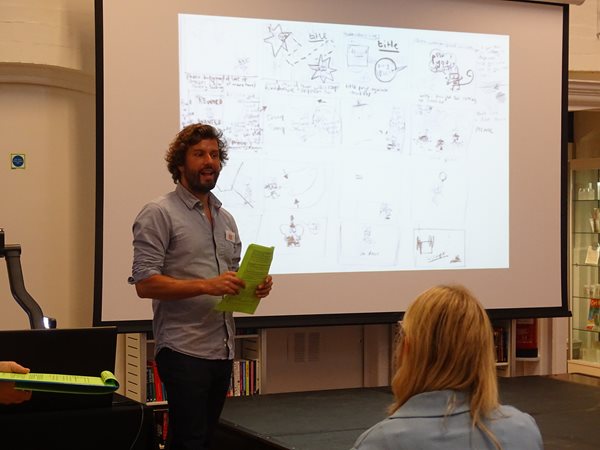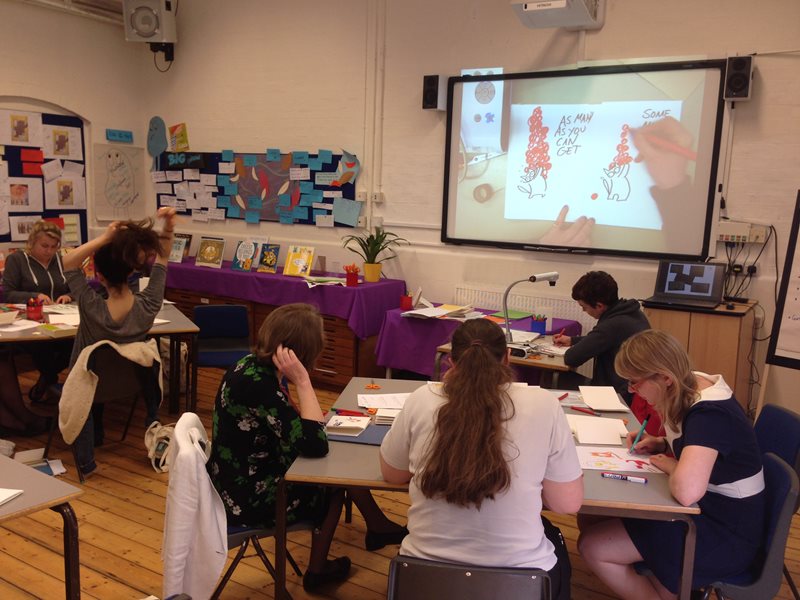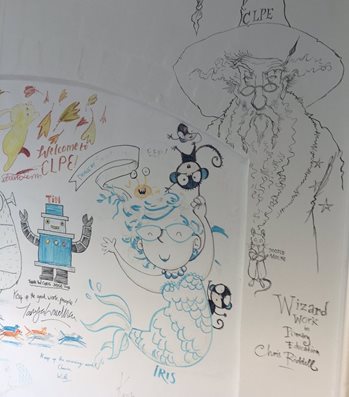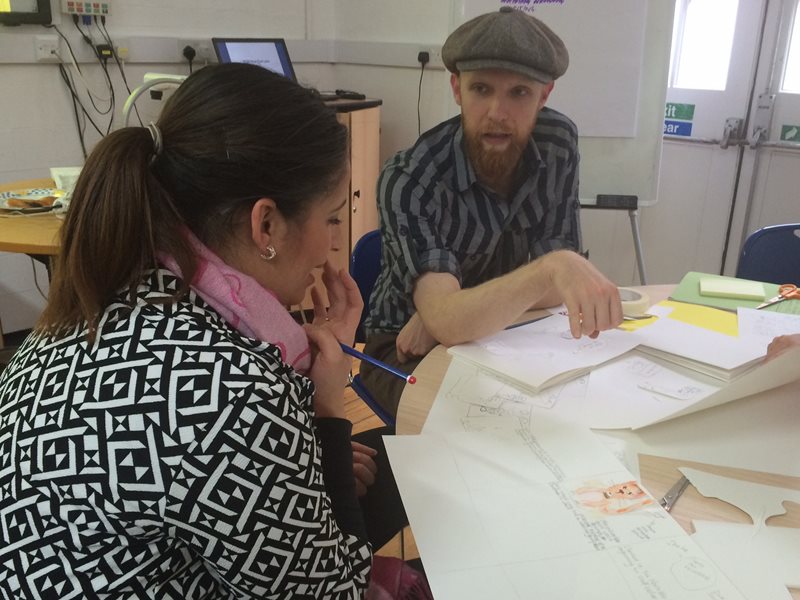Picturebooks are often seen as a first step into reading, but acknowledging their complexity for children of all ages and encouraging children to write their own can have wide-ranging benefits to children’s learning.
At the Centre for Literacy in Primary Education, we’ve spent the last three years working with some of the UK’s leading picturebook authors to develop and deliver a project where we have shown the impact of using picturebooks on children’s engagement and attainment in reading and writing and how to develop successful partnerships between schools using picturebooks and the authors that create them.

Investigating the power of picturebooks in unlocking children’s response to reading had always been an interest of mine. As a Literacy Lead in a London school, I used David McKee’s Not Now Bernard with a Year 6 group, who were struggling to understand inference and deduction. I noticed how these children read the book with entirely new frames of reference related to their wider life experiences and as a boy exclaimed ‘Oh my gosh Miss, there isn’t even a real monster is there? It’s like when my mum says to my brother he’s being a little monster – it’s all about his behaviour!’ I knew that there was untapped potential in reading picturebooks with new eyes and that they were an important part of children’s reading and writing experience at all ages. I shared this view with the author/illustrator Ed Vere at an event investigating partnerships between authors and schools and this led to a conversation about why picturebooks aren’t used across whole schools to create communities of readers and writers. From this conversation, the idea for Power of Pictures was born.

We knew the project would have to incorporate three important elements; training teachers and children in the importance of the close reading of pictures, investigating the link between drawing and writing in picturebook creation and using the skills and expertise of practicing author/illustrators to illustrate what an authentic writing process looks like. In 2014, Ed and I designed and piloted a project working with 12 teachers. It was important for us that this was a partnership between the author and the teachers, exploring and illustrating how writers’ practices could be transferred to today’s classrooms, so we co-planned and delivered the training days building on each other’s ideas and experience as author and teacher. Initial findings showed us that the teachers involved learnt a great deal about the need to spend time closely reading pictures as well as words and how to use drawing as a tool for planning and developing writing. We also knew from feedback and work samples from the teachers involved that the project was having impact on both children’s reading comprehension and writing, especially in those children considered to be ‘lower attaining’ and those with English as an Additional Language.
"Picture books are full of sophisticated meaning"
Ed Vere
This gave us evidence to show the need for such a training programme, developing teacher subject knowledge in close reading of picturebooks and their use in the classroom as a stimulus for children’s own writing. We applied for a three year development grant from Arts Council England to continue the work with nine other author illustrators and 180 teachers. The grant also allowed us to commission Dr Sue Horner and Janet White to undertake a two year evaluation of the programme.
Each two-day project has involved a different author/illustrator. To date, we have worked with Chris Haughton, David Lucas, Viviane Schwarz, Alexis Deacon, Tom McLaughlin, Benji Davies, Mini Grey, Tim Hopgood and Emily Hughes. Although each writer’s experience is different, we have been able to distil common elements important to all the authors to open up to teachers how to read and write picturebooks with their children.
 Drawing on the research and work of Jane Doonan, William Moebius, Morag Styles and Evelyn Arizpe, coupled with the excellent real life experience of author Alexis Deacon, we worked with the evaluators to further develop the first day’s training in reading and response to illustration to expand teacher’s knowledge of the ‘Picturebook Codes’ [1] that illustrators use to convey meaning. Using high quality picturebooks with enough depth for children to respond at different levels depending on their age and experience was also vital. Evaluations from participants have shown the shift in thinking around the value of using picturebooks with older children: ‘My eyes have been opened to the importance of pictures conveying meaning, which I never would have thought had a place in Key Stage 2’. The impact on individual children has also been marked: ‘We have really noticed the impact on a lower ability child, who always spots something in an illustration that no-one else has seen, opening up a new layer of meaning. It not only challenges their perception of themselves as a learner but also other peoples, including mine as the teacher.’
Drawing on the research and work of Jane Doonan, William Moebius, Morag Styles and Evelyn Arizpe, coupled with the excellent real life experience of author Alexis Deacon, we worked with the evaluators to further develop the first day’s training in reading and response to illustration to expand teacher’s knowledge of the ‘Picturebook Codes’ [1] that illustrators use to convey meaning. Using high quality picturebooks with enough depth for children to respond at different levels depending on their age and experience was also vital. Evaluations from participants have shown the shift in thinking around the value of using picturebooks with older children: ‘My eyes have been opened to the importance of pictures conveying meaning, which I never would have thought had a place in Key Stage 2’. The impact on individual children has also been marked: ‘We have really noticed the impact on a lower ability child, who always spots something in an illustration that no-one else has seen, opening up a new layer of meaning. It not only challenges their perception of themselves as a learner but also other peoples, including mine as the teacher.’
The two training days for teachers also explore each author’s processes in creating a picturebook, showing how words and illustration are used to create characters, explore ideas and develop storylines and plots.[2] Through seeing how picturebooks are developed and produced, teachers gain a unique insight into a real writing process and can reflect on how to make this process more authentic in their own classrooms. By the end of the second day, teachers have developed their own character for a picturebook, started to explore plots through sketching and storyboarding and worked with layout of a spread in a handmade dummy book. All the processes demonstrate activities that can be replicated in the classroom with their own children.
"I would like to say to children, 'Don't stop drawing. Don't tell yourself you can't draw.' Everyone can draw. If you make a mark on a page, you can draw."Chris Riddell
In between the course days, teachers take back a copy of the author’s focus text, kindly donated by our publisher partners, and three teaching sequences to their schools. These teaching sequences show them how to put the course teaching into practice in all age groups in their school. The supporting website houses not only these sequences and explanations of the teaching approaches explored, but also videos of the focus author/illustrators introducing themselves and their work, reading their text, illustrating a character and talking about their writing process. These videos help the children to connect with the author. In some schools they have also booked a school visit from the author to support the learning.
Teachers now see the value of including drawing when planning and composing writing rather than making it an activity for ‘after the writing’: ‘Drawing gives children time to think and visualise characters and settings. This helps prepare them for writing. When they do come to write, they have more ideas and better vocabulary as they have spent a lot of time thinking and processing their ideas.’ Again, we saw impact for children who were targeted as needing extra support by schools: ‘I found they were developing characters more fully after visualising and drawing them. The talk at tables was fascinating and all children were motivated to write at greater length – especially the boys.’
The project has developed far beyond our original expectations, particularly the impact we have seen on the authors themselves. Co-planning and leading the courses enabled authors to see how their texts could be developed and used in a classroom setting. Chris Haughton commented: ‘I was amazed that my book which takes two minutes to read could be developed out into such engaging lessons and questioning and exercises over a full day or even several days or weeks. Not only that but in the way it was presented with a few tweaks the same book could work equally well in developing literacy from the very youngest to the older classes in primary.’

Through being part of the courses the authors learned new teaching techniques which they could also use on school visits, knowing how the techniques could engage the children directly and make impact on learning. Tom McLaughlin noted, ‘I am finding more to talk about within the images to a depth I hadn’t considered approaching with them before. I’d never seen that as my job as the author, but my eyes have been opened in that respect.’ Exploring how to work with the teachers and children meant the authors changed their views of their visits from being ‘writer-as-entertainer’ to ‘writer-as-educator’. Following on from the Power of Pictures guidance developed for the schools, the authors said they would now make sure they had contact with teachers before their visits, discussing what would fit with current classroom work and what teachers would welcome as learning for the children. This would mean they were collaborating with the teacher rather than being something of a ‘strange interruption’. As Viviane Schwarz reflected, ‘as valuable as my input might be it's only really useful if it's properly embedded.’
The initial evaluation report was published earlier this year. We are now planning the next phase of the work and are hoping to increase our research base on the impact on particular groups of children, showing that picturebooks play an important role in the curriculum for children of all ages and the value of meaningful partnerships with the authors and illustrators that create them.
Charlotte Hacking is the Learning Programmes Leader at CLPE, an independent UK charity dedicated to helping schools develop literacy learning that transforms lives.
[1] Moebius, William, (1990) "Introduction to picturebook codes" from Hunt, Peter, Children's literature: the development of criticism pp.131-147, London: Routledge
[2] , supported by research from Maria Nikolajeva, Barbara Bader, Perry Nodelman and Martin Sailsbury
Photograph credit:
Photographs courtesy of CLPE
CLPE wall of fame by Louise Johns Shepherd, incl. illustrations by Chris Riddell, Sarah McIntyre, Chris Judge, Alexis Deacon